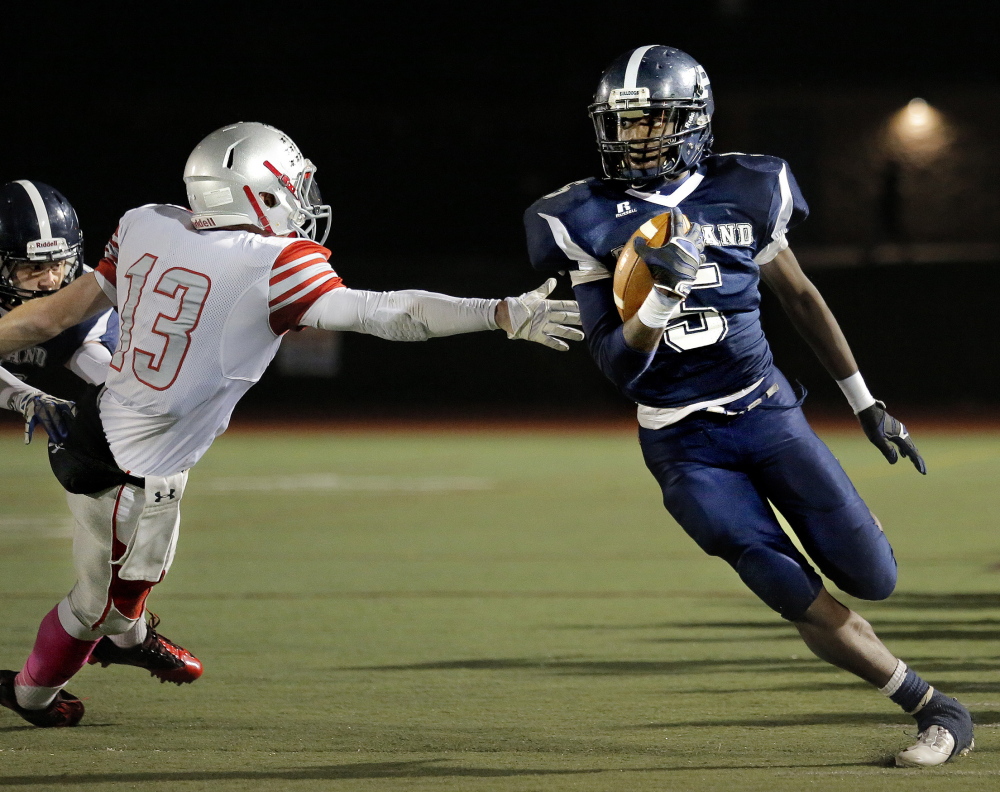HEBRON — It’s an all-star game with the best recently graduated seniors, and in recent years the Lobster Bowl has been a showcase for wide-open offensive play.
If you’re looking for old-fashioned smash-mouth football, the Lobster Bowl is no longer the game for you.
“You see nowadays both offenses are in a spread. I think it better utilizes the talent we have. So many guys get their hands on the ball in that offense,” said B.L. Lippert, the Cony High offensive coordinator who will serve in the same role with the East this year.
“That’s our goal this week, to try to get it to the best players in the state and see them in open space.”
As Maine high school football has evolved, so has the Lobster Bowl. More high school teams than ever are running the spread offense – the offense of choice for both the East and West in recent years.
When the first Lobster Bowl was played in 1990, most Maine teams still relied heavily on the run. The rosters for the first game listed seven players at wide receiver; this year’s game has 17. In 24 games there have been 41 touchdown passes. Twenty-one of those were thrown in the last seven games.
It’s not surprising that the three highest-scoring Lobster Bowl games occurred in those last seven years: a 40-35 East win in 2010, a 47-27 East win in 2007 and the West’s 48-24 win in 2012.
The offensive players in this year’s game, whether they come from a program that ran the spread or not, love it.
“Matt Martin and Ben Lucas (the East quarterbacks), they’re hitting spots and I can’t wait to catch some balls from them,” Messalonskee receiver Devin Warren said.
“We’ve got two great quarterbacks,” said Portland receiver Ronald Hargrove, also on the East. “Both are gunslingers, great quarterbacks.”
Jon Christopher represented Madison as a quarterback in the first Lobster Bowl. Christopher’s experience in the game was a harbinger of what works in the Lobster Bowl now.
“When everybody (on defense) is big, strong and fast, you can’t pound the ball,” Christopher said. “When we opened it up a little in the fourth quarter and mixed the run and pass, we had a little success.”
Lippert, a former Cony quarterback who went on to play at Colby College, played in the lowest-scoring game in the series, when the West won 6-0 in 2000.
“We were in the split-backs, double-dive offense and I hadn’t taken a snap under center in at least two years,” Lippert said. “It was a little bit different. We threw the ball some. We had a spread package but most of the game we were under center. We didn’t move the ball all that well.”
The ground game is still a part of each team’s offense, but tight formations with multiple backs have been replaced by the spread.
A quarterback is as likely to take off with the ball as hand it off. Nate Doehler of Bonny Eagle, a quarterback for the West in 2009, had a then-Lobster Bowl record 72-yard touchdown run.
Teaching and installing the spread offense in a week of practice can be daunting, Lippert said, but not impossible.
“It’s pretty difficult but a lot of these kids have been around the spread and they just have good football aptitudes. They’re focused this week. There’s no real distractions,” Lippert said.
“They’re trying to figure out what plays they might get the ball, what plays they have to block. They’re hungry to get the ball and to win. It hasn’t been as hard as I thought.”
The players have always had the skill to run the spread, but over the last decade the offense’s popularity has grown to the point where there’s enough coaches like Lippert, Mike Hathaway of Leavitt and Kevin Cooper of Bonny Eagle who can teach it well enough to use the spread in the short window of an all-star game like the Lobster Bowl.
“I think we had the talent to (run the spread in 2000). Instead of having six running backs who were all good, they could have gone in the slot and caught the ball,” Lippert said.
“We had a spread package but it was pretty simplistic. Everything was mirrored, everyone ran a hitch, everyone ran deep. But at that time it was sort of evolutionary.”
Any fans not in their seats for the first play shouldn’t worry if they miss a 48-yard fade pass. There will be another coming soon.
“We’re trying to put on a show and score as many points as we can,” Lippert said, “and hopefully both offenses can do that.”
Send questions/comments to the editors.



